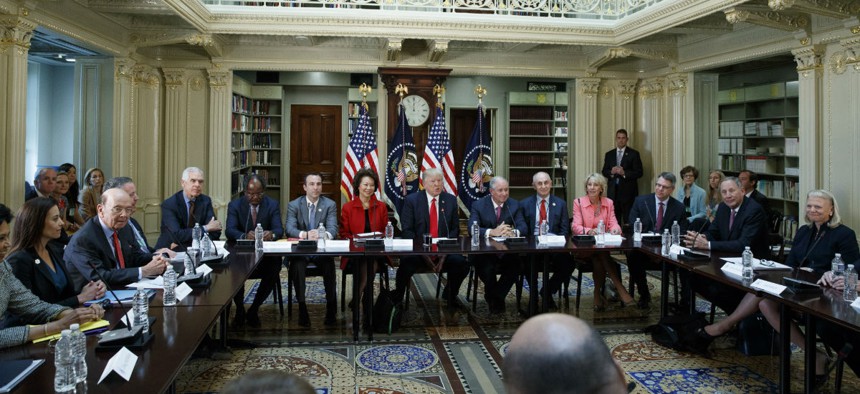Trump Team Plans to Rebuild Government ‘Starting from Scratch’
White House taps agencies to begin reorganization.
Where the Clinton administration tried to “reinvent government,” the Trump administration plans to rebuild government “starting from scratch.”
In a memo to all department and agency heads to be issued Wednesday morning, Budget Director Mick Mulvaney officially ended the hiring freeze President Trump declared on Jan. 23 and ordered agencies to draft plans for overhauling their operations to improve efficiency and cut costs.
In a Tuesday White House preview for reporters, Mulvaney said the administration was flexible on the eventual outcome but said “it’s no secret that the president thinks we can run the government more efficiently with fewer people.”
The memo, titled “Comprehensive Plan for Reforming the Federal Government and Reducing the Federal Workforce,” instructs agencies to immediately began steps toward “near-term workforce reductions” aligned with Trump’s March 13 reorganization order and March 16 fiscal 2018 budget blueprint, and to develop a plan by June 30 to “maximize employee performance.”
By September 2017, following a summer of OMB consultations, agencies are to submit ideas for reorganizing programs and agency organization charts to remove duplication and inefficiency. Those ideas will be incorporated into the administration’s 2019 budget proposal.
“This is a major accomplishment within the president’s first 100 days,” Mulvaney said, calling the planned reorganization “the biggest story nobody’s talking about.” The reform plans are designed to make government “dramatically more accountable, dramatically more efficient, dramatically more effective,” he said.
Compared with past administrations’ efficiency efforts, the Trump approach “has never been done before. The government structure has never been rebuilt,” he told reporters, “and this goes much deeper, to the very structure of government.” It amounts to “restructuring Washington, D.C.”
Mulvaney acknowledged he had not studied the proposals President Obama sent up to Capitol Hill in 2012 and 2015, which sought efficiencies by consolidating several agencies into a new Trade and Business department, nor did he recall the reform efforts under Presidents Clinton or Reagan.
Mulvaney spoke just hours after Trump met with corporate CEOs under the auspices of the new White House Office of American Innovation, which is slated to help run the reorganization. They suggested “that government restructure by function instead of following the organic structure of the past two centuries, or the 12 appropriations bills,” he said.
A sample of the current inefficiency, he said, are the 43 different workforce training programs spread over 13 agencies. “If everyone’s responsible, no one’s responsible,” and when government “is not functioning at its best, there’s no one to ask,” Mulvaney said.
The administration wants to reduce duplication, eliminate reporting burdens, delegate more responsibilities to states, move more services online and co-locate more offices. Mulvaney offered one hypothetical example of the kind of idea the administration would consider: The possibility that the National Nuclear Security Administration, for 16 years a part of the Energy Department, could conceivably move to the Defense Department.
“When justifying proposals to OMB, agencies should be prepared to discuss how they conducted their analysis and provide relevant evidence,” the guidance says. “In addition to agency-specific reform proposals, OMB will work with agencies and key stakeholders to develop reform proposals that involve multiple agencies.”
OMB plans to measure progress using tools in the 2010 Government Performance and Results Modernization Act, such as cross-agency priority goals, annual strategic reviews and the website Performance.gov.
Among the advisers on crafting the memo was Linda Springer, a veteran of the Office of Personnel Management and OMB in the George W. Bush administration, who attended the preview.
The White House plans to work with Congress and public stakeholders where new laws may be needed. Mulvaney acknowledged that “Congress’s priorities may be a little different,” but is “hopeful for a buy-in.” Lawmakers “know how poorly run and inefficient government is. We won’t step on any toes,” he said.
As for enforcement, Mulvaney said OMB would monitor agencies' efforts. Some agencies might need to add employees, where others would cut staff, he said.
Mulvaney denied any “ideological pre-conditions” on what reform will ultimately look like. “There’s a knee-jerk Republican answer to say there must be fewer agencies,” he said, “but it might make things more efficient if you had not fewer but smaller agencies.”
“Draining the swamp” he said, “is not big government or smaller government but good government.”
At least one government performance specialist, after reading a transcript of Mulvaney’s press conference, was impressed. “The best news out of the White House today is the lifting of a governmentwide hiring freeze,” said Robert Shea, a veteran of OMB under George W. Bush and now a principal with Grant Thornton LLP.
“Agencies can now begin to carefully recruit the talent they need to accomplish the government’s mission. “Reorganizing by function is an excellent idea, but it’s much easier said than done,” he warned. “Because government’s structure has evolved so haphazardly over the last two centuries, it is well worth the effort.”




